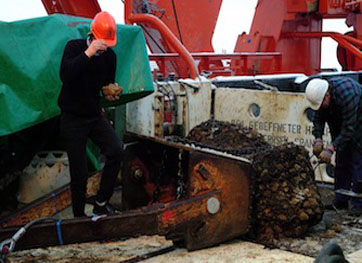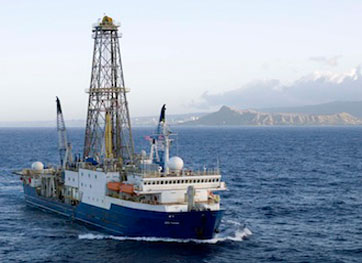Jonathan Snow to Lead International Drilling Expedition
Voyage to Give Scientists Glimpse into Earth's Development
On a previous expedition to the North Pole in 2008, UH geologist Jonathan Snow (left) inspects a haul of rocks scooped up from the floor of the Arctic Ocean. (Credit: Heinz Feldmann, Max-Planck Insitut für Chemie).From finding the first deep-water hydrocarbons in the Gulf of Mexico to locating the meteorite impact that doomed the dinosaurs, scientific ocean drilling has unlocked some major mysteries. A University of Houston (UH) geologist hopes to uncover more such secrets as co-chief scientist on a major international expedition to recover the first-ever drill core from the lower crust of the Pacific Ocean.
Jonathan E. Snow, an associate professor in the Department of Earth and Atmospheric Sciences, will co-lead 28 scientists, chosen from hundreds of applicants around the world, aboard the JOIDES Resolution research vessel on a voyage supported by the Integrated Ocean Drilling Program. The geoscientists on this two-month, $10 million expedition will gather rock samples and data from the lower crust of the ocean that will distinguish between two competing theories on the rate and location of the intrusion of magma into the Earth’s lowermost crust.
“We will be the first to see the rocks that test these models, with the rest of the global ocean crust community eagerly waiting to see the results,” Snow said. “Volcanoes are spectacular things, but they do much more than pose hazards for human populations. They are directly responsible for creating the ocean crust beneath two-thirds of our planet. Deep beneath the volcanic eruptions, molten magma that doesn’t erupt cools slowly to form the crystalline layers of the deep crust, through processes that we don’t yet understand well.”
UH Professor Jonathan Snow will embark on a two-month journey aboard the JOIDES Resolution research vessel. Pictured here, the ship is shown departing Honolulu in 2009 for a prior expedition. (Credit: William Crawford, IODP/TAMU).Covered by miles of water and rock, the deepest layers of the ocean crust are about as inaccessible as it gets, and little was known about them until the 1970s, when deep-diving submersibles and deep-water drilling vessels came on the scene. Since then, scientific drilling has discovered that the ocean crust is formed by a continuous process of volcanic seafloor spreading, one of the key revelations that led to the acceptance of the theory of plate tectonics governing many of the key processes that shape the Earth.
“The formation of the deepest layers, the intrusive lower crust, is the most difficult part to study, because it’s situated not only beneath three to five miles of seawater and sediment, but also beneath the extrusive upper layers,” Snow said. “Getting at these deep layers requires a combination of deep drilling, using advanced technologies developed for oilfield use, and a location where deep cracks in the Earth remove much of the volcanic layer, making the lower crust more accessible.”
The JOIDES Resolution is the ship that will drill into the lower crust. Designed for deep-sea exploration, it is more than 450 feet long, with a drilling derrick, accommodations for 130 people and a floating laboratory for the analysis of core samples. Snow will share his co-chief scientist duties with Kathryn Gillis, professor in the School of Earth and Ocean Sciences and associate dean of the Faculty of Science, at the University of Victoria in Canada. They will join 26 other international scientists on this expedition from December to February.
“Researchers work their entire careers to be co-chief scientist on one of these expeditions,” Snow said. “I am flattered that my name came to the top of the list. I’m only the second person from UH ever to get the call.”
- Lisa Merkl, University Communication

